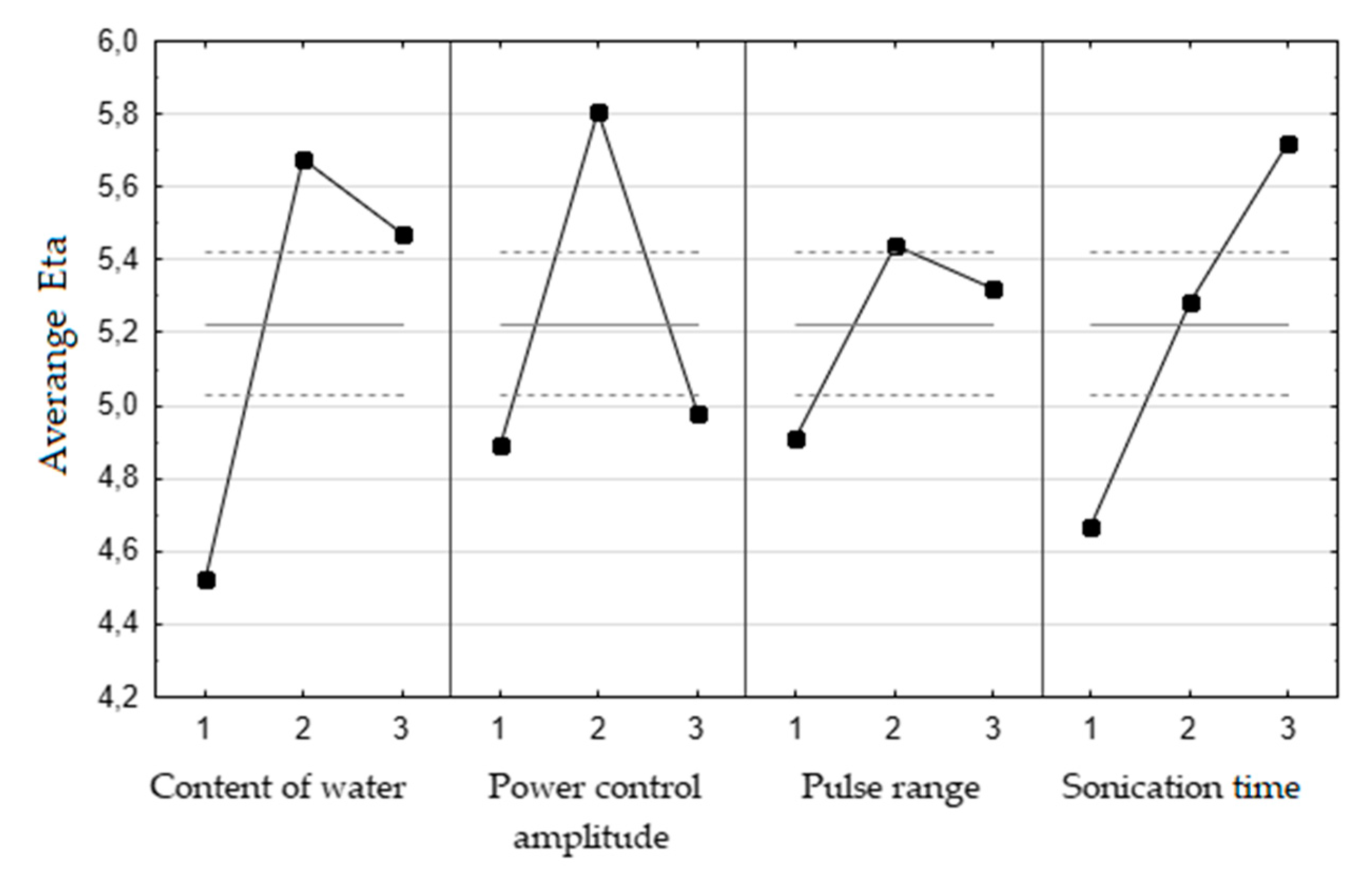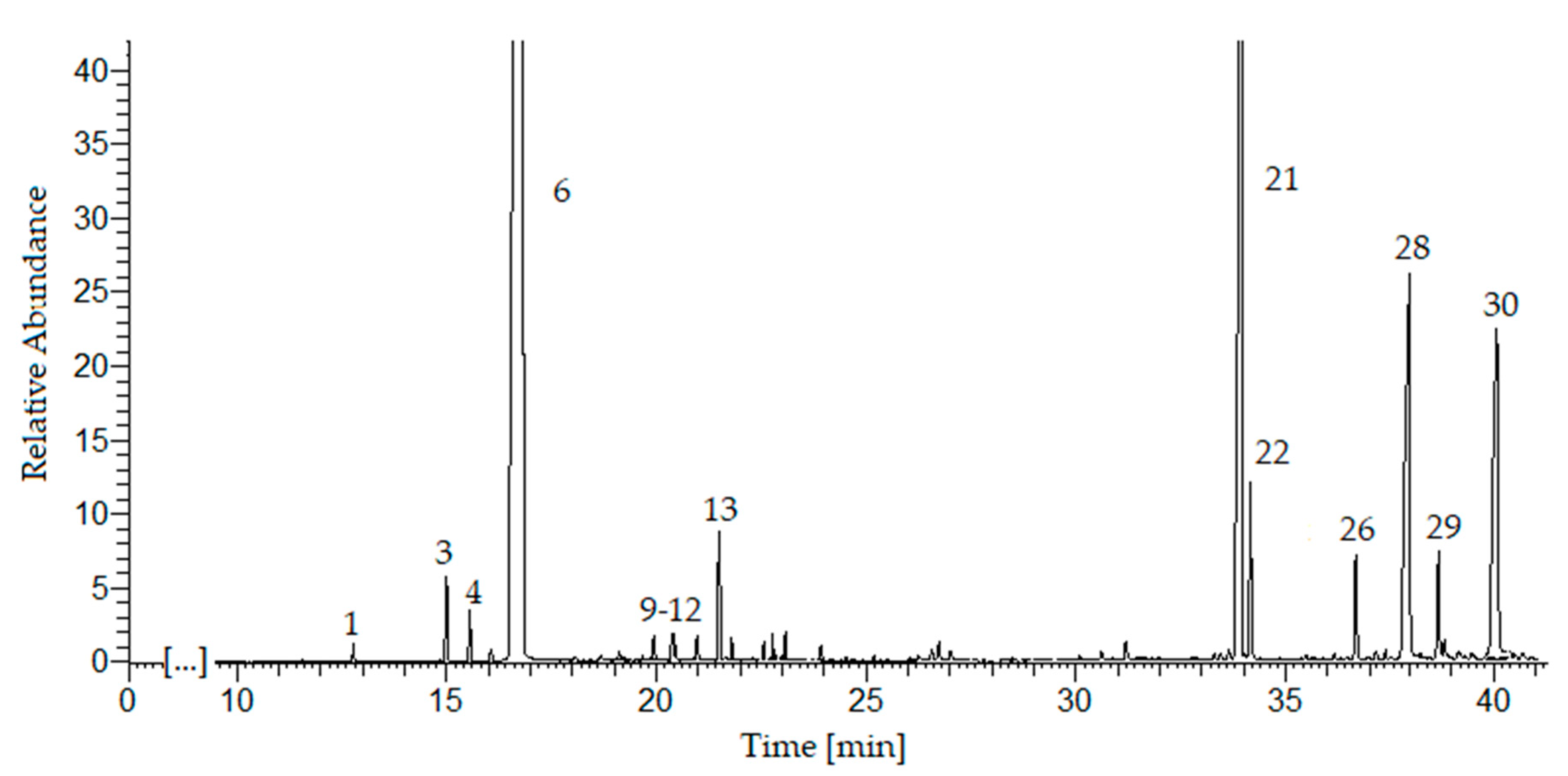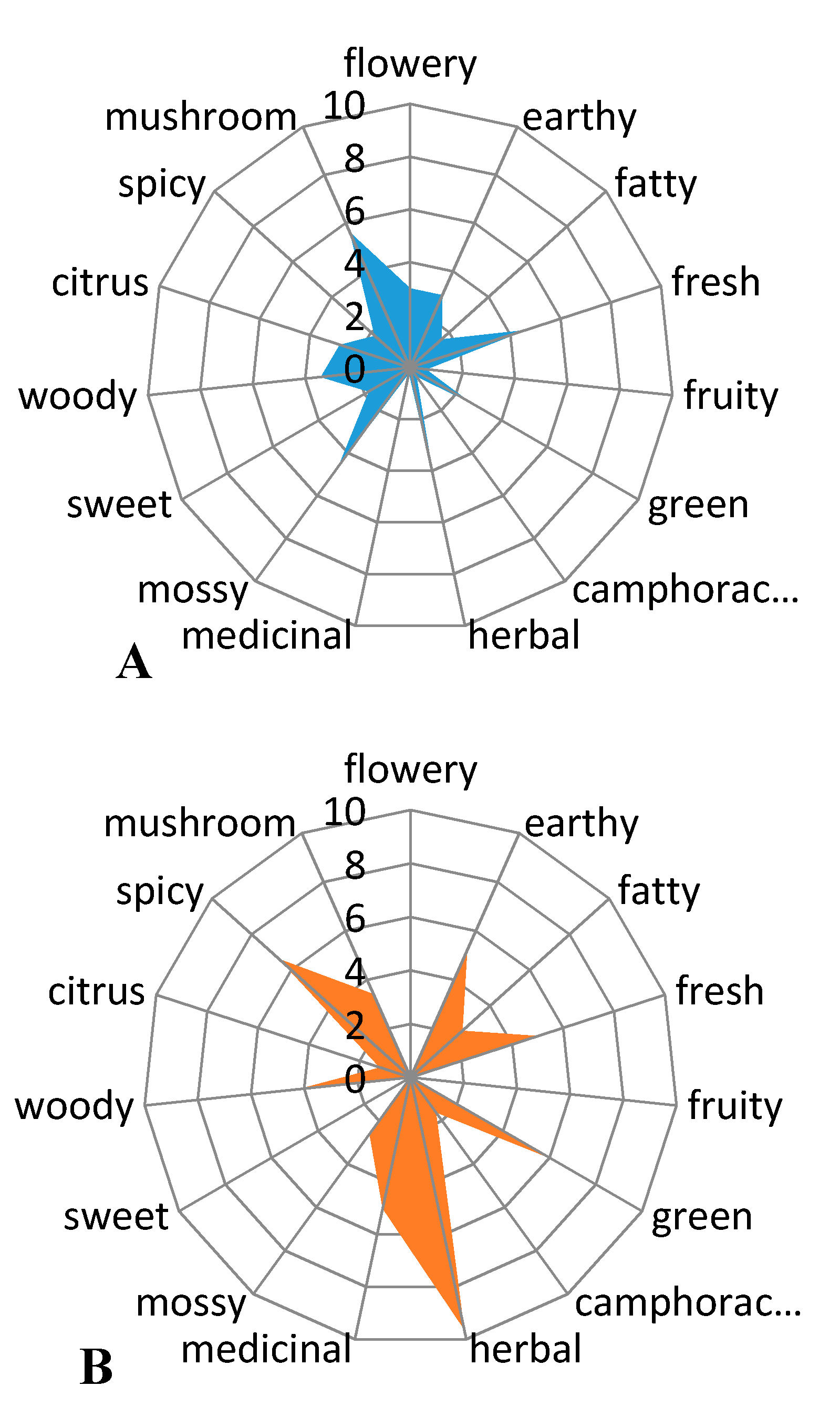Ultrasound-Assisted Hydrodistillation of Essential Oil from Celery Seeds (Apium graveolens L.) and Its Biological and Aroma Profiles
Abstract
1. Introduction
2. Results and Discussion
2.1. Taguchi Experimental Design Approach
2.2. Efficiency of Ultrasonic Hydrodistillation
2.3. Physicochemical Parameters
2.4. Chemical Composition
2.5. Similarity Analysis
2.6. Antimicrobial Activity
2.7. Antioxidant Activity
2.8. Aroma Profile
3. Materials and Methods
3.1. Plant Material
3.2. Taguchi Experimental Design Approach
3.3. Application of Ultrasounds
3.4. Hydrodistillation Process
3.5. Physicochemical Parameters
3.6. Gas Chromatography-Mass Spectrometry with Flame Ionization Detection (GC-FID)
3.7. Similarity Analysis
3.8. Near-Infrared (NIR) and Mid-Infrared (MIR) Spectroscopy
3.9. Antimicrobial Activity Assay
3.10. Antioxidant Activity
3.11. Aroma Profile
4. Conclusion
Author Contributions
Funding
Conflicts of Interest
Sample Availability: Samples of the compounds are not available from the authors. |
References
- Selvamuthukumaran, M.; Shi, J. Recent advances in extraction of antioxidants from plant by-products processing industries. Food Qual. Saf. 2017, 1, 61–81. [Google Scholar] [CrossRef]
- Śmigielski, K.B.; Majewska, M.; Kunicka-Styczyńska, A.; Gruska, R. The effect of ultrasound-assisted maceration on the bioactivity, chemical composition and yield of essential oil from waste carrot seeds (Daucus carota). J. Essent. Oil Bear. Plants 2014, 17, 1075–1086. [Google Scholar] [CrossRef]
- Rassem, H.H.A.; Nour, A.H.; Yunus, R.M. Techniques for extraction of essential oils from plants: A review. Aust. J. Basic Appl. Sci. 2016, 10, 117–127. [Google Scholar]
- Zor, Ş.D.; Bat, M.; Peksel, A.; Alpdoğan, G. Optimization of ultrasound-assisted extraction of antioxidants from Apium graveolens L. seeds using response surface methodology. J. Turk. Chem. Soc. Section A Chem. 2017, 4, 915–930. [Google Scholar] [CrossRef]
- Kooti, W.; Daraei, N. A review of the antioxidant activity of celery (Apium graveolens L.). J. Evid. Based Complementary Altern. Med. 2017, 22, 1029–1034. [Google Scholar] [CrossRef] [PubMed]
- Salehi, B.; Venditti, A.; Frezza, C.; Yücetepe, A.; Altuntaȿ, Ü.; Uluata, S.; Butnariu, M.; Sarac, I.; Shaheen, S.; Petropoulos, S.A.; et al. Apium plants: Beyond simple food and phytopharmacological applications. Appl. Sci. 2019, 9, 3547. [Google Scholar] [CrossRef]
- Mwaurah, P.W.; Kumar, S.; Kumar, N.; Attkan, A.K.; Panghal, A.; Singh, V.K.; Garg, M.K. Novel oil extraction technologies: Process conditions, quality parameters, and optimization. Compr. Rev. Food Sci. Food Saf. 2020, 19, 3–20. [Google Scholar] [CrossRef]
- Miljanović, A.; Bielen, A.; Grbin, D.; Marijanović, Z.; Andlar, M.; Rezić, T.; Roca, S.; Jerković, I.; Vikić-Topić, D.; Dent, M. Effect of enzymatic, ultrasound, and reflux extraction pretreatments on the chemical composition of essential oils. Molecules 2020, 25, 4818. [Google Scholar] [CrossRef]
- Hsieh, S.-L.; Chen, C.-T.; Wang, J.-J.; Kuo, Y.-H.; Li, C.-C.; Hsieh, L.-C.; Wu, C.-C. Sedanolide induces autophagy through the PI3K, p53 and NF-κB signaling pathways in human liver cancer cells. Int. J. Oncol. 2015, 47, 2240–2246. [Google Scholar] [CrossRef]
- Kowalski, R.; Wawrzykowski, J. Effect of ultrasound-assisted maceration on the quality of oil from the leaves of thyme Thymus vulgaris L. Flavour Fragr. J. 2009, 24, 69–74. [Google Scholar] [CrossRef]
- Kowalski, R.; Kowalska, G.; Jamroz, J.; Nawrocka, A.; Metyk, D. Effect of the ultrasound-assisted preliminary maceration on the efficiency of the essential oil distillation from selected herbal raw materials. Ultrason. Sonochem. 2015, 24, 214–220. [Google Scholar] [CrossRef] [PubMed]
- Kowalski, R.; Gagoś, M.; Kowalska, G.; Pankiewicz, U.; Sujka, M.; Mazurek, A.; Nawrocka, A. Effects of ultrasound technique on the composition of different essential oils. J. Anal. Methods Chem. 2019, 2019, 1–10. [Google Scholar] [CrossRef] [PubMed]
- Dąbrowska, J.A.; Kunicka-Styczyńska, A.; Śmigielski, K. Biological, chemical, and aroma profiles of essential oil from waste celery seeds (Apium graveolens L.). J. Essent. Oil Res. 2020. [Google Scholar] [CrossRef]
- Kiralan, M.; Bayrak, A.; Abdulaziz, O.F.; Özbucak, T. Essential oil composition and antiradical activity of the oil of Iraq plants. Nat. Prod. Res. 2012, 26, 132–139. [Google Scholar] [CrossRef] [PubMed]
- Khalid, K.A.; Hussein, M.S. Effect of cattle and liquid manures on essential oil and antioxidant activities of celery (Apium graveolens L.) fruits. J. Essent. Oil Bear. Plants 2012, 15, 97–107. [Google Scholar] [CrossRef]
- Hassanen, N.H.; Eissa, A.M.F.; Hafez, S.A.M.; Mosa, E.A.M. Antioxidant and antimicrobial activity of celery (Apium graveolens) and coriander (Coriandrum sativum) herb and seed essential oils. Int. J. Curr. Microbiol. App. Sci. 2015, 4, 284–296. [Google Scholar]
- Zhang, X.; Xiao, H.; Xu, Q.; Li, X.; Wang, J.; Liang, X. Characterization of phthalides in Ligusticum chuanxiong by liquid chromatographic-atmospheric pressure chemical ionization-mass spectrometry. J. Chromatogr. Sci. 2003, 41, 428–433. [Google Scholar] [CrossRef]
- Miller, J.A.; Pappan, K.; Thompson, P.A.; Want, E.J.; Siskos, A.P.; Keun, H.C.; Wulff, J.; Hu, C.; Lang, J.E.; Chow, H.H.S. Plasma metabolomic profiles of breast cancer patients after short-term limonene intervention. Cancer Prev. Res. 2015, 8, 86–95. [Google Scholar] [CrossRef]
- Andrade, B.F.M.T.; Barbosa, L.N.; Probst, I.S.; Fernandes, A.J. Antimicrobial activity of essential oils. J. Essent. Oil Res. 2014, 26, 34–40. [Google Scholar] [CrossRef]
- Tarek, N.; Hassan, H.M.; Abdel-Ghani, S.M.M.; Radwan, I.A.; Hammouda, O.; El-Gendy, A.O. Comparative chemical and antimicrobial study of nine essential oils obtained from medicinal plants growing in Egypt. Beni-Suef Univ. J. Basic Appl. Sci. 2014, 3, 149–156. [Google Scholar] [CrossRef]
- Thakre, A.; Zore, G.; Kodgire, S.; Kazi, R.; Mulange, S.; Patil, R.; Shelar, A.; Santhakumari, B.; Kulkarni, M.; Kharat, K.; et al. Limonene inhibits Candida albicans growth by inducing apoptosis. Med. Mycol. 2018, 56, 565–578. [Google Scholar] [CrossRef] [PubMed]
- Ünal, M.U.; Uçan, F.; Sener, A.; Dinçer, S. Research on antifungal and inhibitory effects of dl-limonene on some yeasts. Turk. J. Agric. For. 2012, 36, 576–582. [Google Scholar] [CrossRef]
- Baananou, S.; Bouftira, I.; Mahmoud, A.; Boukel, K.; Marongiu, B.; Boughattas, N.A. Antiulcerogenic and antibacterial activities of Apium graveolens essential oil and extract. Nat. Prod. Res. 2013, 27, 1075–1083. [Google Scholar] [CrossRef] [PubMed]
- Din, Z.U.; Shad, A.A.; Bakht, J.; Ullah, I.; Jan, S. In vitro antimicrobial, antioxidant activity and phytochemical screening of Apium graveolens. Pak. J. Pharm. Sci. 2015, 28, 1699–1704. [Google Scholar]
- Kulisic, T.; Radonic, A.; Katalinic, V.; Milos, M. Use of different methods for testing antioxidative activity of oregano essential oil. Food Chem. 2004, 85, 633–640. [Google Scholar] [CrossRef]
- Leyva-López, N.; Gutiérrez-Grijalva, E.P.; Vazquez-Olivo, G.; Heredia, J.B. Essential Oils of Oregano: Biological Activity beyond Their Antimicrobial Properties. Molecules 2017, 22, 989. [Google Scholar] [CrossRef]
- Ahmed, A.F.; Shi, M.; Liu, C.; Kang, W. Comparative analysis of antioxidant activities of essential oils and extracts of fennel (Foeniculum vulgare Mill.) seeds from Egypt and China. Food Sci. Hum. Wellness 2019, 8, 67–72. [Google Scholar] [CrossRef]
- Wei, A.; Shibamoto, T. Antioxidant activities and volatile constituents of various essential oils. J. Agric. Food Chem. 2007, 55, 1737–1742. [Google Scholar] [CrossRef]
- Śmigielski, K.; Raj, A.; Krosowiak, K.; Gruska, R. Chemical composition of the essential oil of Lavandula angustifolia cultivated in Poland. J. Essent. Oil Bear. Plants 2009, 12, 338–347. [Google Scholar] [CrossRef]
- El-Zaeddi, H.; Martínez-Tomé, J.; Calín-Sánchez, Á.; Burló, F.; Carbonell-Barrachina, Á.A. Volatile composition of essential oils from different aromatic herbs grown in Mediterranean regions of Spain. Foods 2016, 5. [Google Scholar] [CrossRef]



| Test No. | Sonication Time (min) | Pulse Range | Power Control Amplitude (%) | Content of Water (mL) | Essential Oil Yield (g/100 g of Seeds) | Eta |
|---|---|---|---|---|---|---|
| 1 | 5 | 0.1 | 20 | 350 | 1.456 ± 0.011 | 3.318555 |
| 2 | 5 | 0.5 | 60 | 700 | 1.978 ± 0.048 | 5.922812 |
| 3 | 5 | 1 | 100 | 950 | 1.731 ± 0.035 | 4.763080 |
| 4 | 20 | 0.1 | 60 | 950 | 1.949 ± 0.029 | 5.797067 |
| 5 | 20 | 0.5 | 100 | 350 | 1.690 ± 0.011 | 4.557621 |
| 6 | 20 | 1 | 20 | 700 | 1.884 ± 0.015 | 5.501434 |
| 7 | 50 | 0.1 | 100 | 700 | 1.908 ± 0.061 | 5.607108 |
| 8 | 50 | 0.5 | 20 | 950 | 1.961 ± 0.045 | 5.846586 |
| 9 | 50 | 1 | 60 | 350 | 1.927 ± 0.043 | 5.697718 |
| Factor | Level | Effect Size | Standard Error |
|---|---|---|---|
| Contents of water [mL] | 2 | 0.453565 | 0.097524 |
| Power control amplitude [%] | 2 | 0.582312 | 0.097524 |
| Pulse range | 2 | 0.218786 | 0.097524 |
| Sonication time [min] | 3 | 0.493584 | 0.097524 |
| Expected S/N ratio | 6.971801 | ||
| No. | Chemical Compound | RT (min) | RIE | RIL | Area (%) | |
|---|---|---|---|---|---|---|
| EOUAH | EOHD * | |||||
| 1 | α-pinene | 12.8 | 937 | 940 | 0.1 | 0 |
| 2 | sabinene | 14.4 | 967 | 965 | tr | 0 |
| 3 | β-pinene | 15.0 | 980 | 972 | 0.8 | 0 |
| 4 | β-myrcene | 15.5 | 993 | 992 | 0.6 | 0.1 |
| 5 | p-cymene | 16.3 | 1013 | 1011 | tr | 0 |
| 6 | limonene | 16.8 | 1026 | 1027 | 76.9 | 1 |
| 7 | β-linalool | 19.2 | 1085 | 1082 | tr | 0.1 |
| 8 | octen-1-ol acetate | 19.5 | 1100 | 1102 | tr | 0 |
| 9 | trans-p--mentha-2,8-dien-1-ol | 19.9 | 1103 | 1103 | 0.1 | 0 |
| 10 | limona ketone | 20.0 | 1106 | 1105 | tr | 0 |
| 11 | cis-p-mentha-2,8-dien-1-ol | 20.4 | 1116 | 1116 | 0.2 | 0.1 |
| 12 | limonene oxide | 21.3 | 1138 | 1138 | 0.1 | 0 |
| 13 | pentylbenzene | 21.5 | 1144 | 1146 | 0.7 | −0.1 |
| 14 | 1-pentylcyclohexa-1,3-diene | 21.7 | 1148 | 1156 | 0.1 | 0 |
| 15 | p-mentha-1,8-dien-4-ol | 22.1 | 1167 | 1174 | tr | 0 |
| 16 | trans-isocarveol | 22.5 | 1169 | 1175 | tr | 0 |
| 17 | cis-dihydrocarvone | 22.6 | 1171 | 1167 | 0.1 | 0 |
| 18 | α-terpineol | 22.9 | 1179 | 1179 | 0.1 | 0 |
| 19 | dihydrocarveol | 23.0 | 1181 | 1181 | 0.1 | 0 |
| 20 | α-curcumene | 23.9 | 1479 | 1472 | tr | 0 |
| 21 | β-selinene (β-eudesmene) | 34.0 | 1487 | 1491 | 9.7 | 0.4 |
| 22 | α-selinene (α-eudesmene) | 34.2 | 1494 | 1500 | 1.4 | 0.1 |
| 23 | 7-epi-α-selinene | 35.4 | 1532 | 1526 | tr | 0 |
| 24 | selina-3,7(11)-diene | 35.5 | 1540 | 1535 | tr | 0 |
| 25 | hedycariol | 36.1 | 1545 | 1541 | tr | 0 |
| 26 | β-caryophyllene oxide | 36.7 | 1573 | 1576 | 0.5 | 0 |
| 27 | humulene epoxide 2 | 37.5 | 1597 | 1601 | tr | 0 |
| 28 | 3-butylphthalide | 38.0 | 1626 | 1629 | 3.6 | 0.5 |
| 29 | β-eudesmol | 38.7 | 1639 | 1644 | 0.5 | 0.1 |
| 30 | sedanenolide (senkyunolide A) | 39.9 | 1698 | 1701 | 3.4 ** | −1.1 |
| total | 99.0 | |||||
| monoterpenes | 78.4 | |||||
| monoterpenoids | 0.7 | |||||
| sesquiterpenes | 11.1 | |||||
| sesquiterpenoids | 1.0 | |||||
| other hydrocarbons | 7.8 | |||||
| Strain | MIC (μL/mL) | MBC/MFC * (μL/mL) |
|---|---|---|
| Escherichia coli ATCC 1627 | 10 | 70 |
| Psudomonas aeruginosa ATCC 1555 | 30 | 100 |
| Bacillus subtilis ATCC 6633 | 20 | 150 |
| Staphylococcus aureus ATCC 1803 | 3 | 20 |
| Aspergillus niger LOCK 16404 | 40 | >300 * |
| Penicillum expansum LOCK 0535 | 40 | >300 * |
| Candida vini LOCK 0008 | 30 | 120 * |
| Concentration of Essential Oil (g/L) | 2.5 | 5.0 | 10.0 | 20.0 | 50.0 | 100.0 |
|---|---|---|---|---|---|---|
| DPPH radicals scavenging effect (%) | 34.5 ± 0.3 | 35.3 ± 0.3 | 37.9 ± 0.3 | 39.6 ± 0.3 | 44.8 ± 0.4 | 52.9 ± 0.4 |
| Trolox Equivalents (µg/mL) | 5.6 ± 0.3 | 5.8 ± 0.3 | 6.4 ± 0.3 | 6.9 ± 0.3 | 8.2 ± 0.4 | 10.2 ± 0.4 |
| IC50 parameter (g/L) | 81.6 | |||||
| Test No. | Sonication Time (min) | Pulse Range | Power Control Amplitude (%) | Content of Water (mL) |
|---|---|---|---|---|
| 1 | 5 | 0.1 | 20 | 350 |
| 2 | 5 | 0.5 | 60 | 700 |
| 3 | 5 | 1 | 100 | 950 |
| 4 | 20 | 0.1 | 60 | 950 |
| 5 | 20 | 0.5 | 100 | 350 |
| 6 | 20 | 1 | 20 | 700 |
| 7 | 50 | 0.1 | 100 | 700 |
| 8 | 50 | 0.5 | 20 | 950 |
| 9 | 50 | 1 | 60 | 350 |
Publisher’s Note: MDPI stays neutral with regard to jurisdictional claims in published maps and institutional affiliations. |
© 2020 by the authors. Licensee MDPI, Basel, Switzerland. This article is an open access article distributed under the terms and conditions of the Creative Commons Attribution (CC BY) license (http://creativecommons.org/licenses/by/4.0/).
Share and Cite
Zorga, J.; Kunicka-Styczyńska, A.; Gruska, R.; Śmigielski, K. Ultrasound-Assisted Hydrodistillation of Essential Oil from Celery Seeds (Apium graveolens L.) and Its Biological and Aroma Profiles. Molecules 2020, 25, 5322. https://doi.org/10.3390/molecules25225322
Zorga J, Kunicka-Styczyńska A, Gruska R, Śmigielski K. Ultrasound-Assisted Hydrodistillation of Essential Oil from Celery Seeds (Apium graveolens L.) and Its Biological and Aroma Profiles. Molecules. 2020; 25(22):5322. https://doi.org/10.3390/molecules25225322
Chicago/Turabian StyleZorga, Justyna, Alina Kunicka-Styczyńska, Radosław Gruska, and Krzysztof Śmigielski. 2020. "Ultrasound-Assisted Hydrodistillation of Essential Oil from Celery Seeds (Apium graveolens L.) and Its Biological and Aroma Profiles" Molecules 25, no. 22: 5322. https://doi.org/10.3390/molecules25225322
APA StyleZorga, J., Kunicka-Styczyńska, A., Gruska, R., & Śmigielski, K. (2020). Ultrasound-Assisted Hydrodistillation of Essential Oil from Celery Seeds (Apium graveolens L.) and Its Biological and Aroma Profiles. Molecules, 25(22), 5322. https://doi.org/10.3390/molecules25225322






